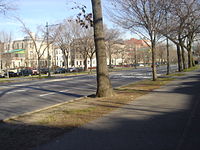This article refers to Eastern Parkway in Brooklyn, New York: there is also an Eastern Parkway in Louisville, Kentucky, also designed by the firm of Frederick Law Olmsted. Eastern Parkway U.S. National Register of Historic Places 250px Near New York Avenue in Crown Heights. Location: Brooklyn, New York CityBuilt: 1870Architect: Frederick Law Olmsted; Calvert VauxGoverning body: StateNRHP Reference#: 83001689Added to NRHP: September 26, 1983 Eastern Parkway is a major boulevard that runs through a portion of the New York City borough of Brooklyn. The road begins at Grand Army Plaza and extends east, running parallel to Atlantic Avenue, along the crest of the moraine that separates northern from southern Long Island, to Ralph Avenue. There, it turns to the northeast, still following the moraine, until it terminates at Evergreen Cemetery where the moraine takes a steep climb towards a peak at Ridgewood Reservoir. In the short westernmost portion, between Grand Army Plaza and Washington Avenue, the thoroughfare consists of a broad, bidirectional avenue of six lanes, separated by a median from a narrow parallel side street on the north side. The section between Washington and Ralph Avenues has also a southern side street, separated by another median. Both medians have trees, benches, subway stations, and paths for pedestrians. The southern one has a bike path, part of the Brooklyn-Queens Greenway which runs south from the western end through Prospect Park to Ocean Parkway and east from the eastern end through Forest Park (Queens). East of Ralph Avenue, the parkway is reduced to four lanes, heading in a northeasterly direction towards the Jackie Robinson Parkway. Eastern Parkway is credited as the world's first parkway. According to the New York City Department of Parks and Recreation's description of Eastern Parkway: The world's first parkway was conceived by Frederick Law Olmsted and Calvert Vaux in 1866. The term parkway was coined by these designers as a landscaped road built expressly for 'pleasure-riding and driving' or scenic access to Prospect Park (also designed by Olmsted and Vaux). To these ends, commerce was restricted. The parkway was constructed from Grand Army Plaza to Ralph Avenue (the boundary of the City of Brooklyn) between 1870 and 1874. Olmsted and Vaux intended Eastern Parkway to be the Brooklyn nucleus of an interconnected park and parkway system for the New York area. The plan was never completed but their idea of bringing the countryside into the city influenced the construction of major parks and parkways in cities throughout the United States. The success of the special statutory commercial restrictions on this and other urban parkways inspired later, more general zoning schemes in New York and elsewhere. The parkway was planned as an important urban design element to create an amenity for a good neighborhood. Like some later roads on Long Island, Eastern Parkway was designed to use land that was idle because it was high, rocky, and unsuited to farming. The presence of the road, however, made the area residentially desirable for people whose income derived from elsewhere. Thus it became inhabited in the next few decades, while land on slopes to the south and north continued to be used for farms into the 20th century, when the IRT Eastern Parkway Line subway was built under the parkway. Many trees along the parkway bear plaques commemorating soldiers fallen in World War I. In addition to Grand Army Plaza and Prospect Park, other attractions and notable buildings along Eastern Parkway include the Brooklyn Public Library central branch, the Brooklyn Museum, the Brooklyn Botanical Gardens, 770 Eastern Parkway, Zion Triangle and the Jewish Children's Museum. The parkway is the route of the West Indian Day Parade, a festive annual celebration taking place around Labor Day.

Year of construction
1870



Comment
0